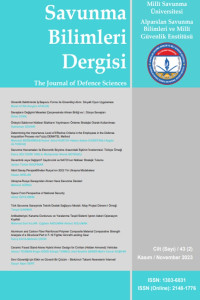Öz
Askeri operasyonlarda kontrolsüz kanamalar ve travmatik yaralanmalara bağlı ciddi komplikasyonlar, askerlerin önlenebilir ölüm nedenlerinin başında gelmektedir. Askeri kayıpların %50'den fazlası ve dünya çapındaki ölümlerin %30'u travmatik yaralanmalara bağlıdır. Operasyon koşullarında meydana gelen yaralanmalar için kanamanın durdurulması ve antimikrobiyal etki sağlanması sınırlı sağlık hizmeti varlığında, tıbbi merkeze ulaşana kadar hayati önem taşımaktadır. Bu kapsamda, müdahale şansının düşük olduğu koşullarda müdahaleye kadar kıyafetin kısmi de olsa koruma sağlıyor olması katma değer sağlamaktadır. Bu çalışmada askeri kıyafetlerde kullanılacak, operasyon koşullarında meydana gelebilecek yaralanmaları tespit eden, enfeksiyonlara karşı koruma ve kanamaları durdurma özeliğini sağlayan bir sistem geliştirilmiştir. Bu kapsamda antimikrobiyal ve hemostaz özelliklerine sahip nanolifli katmanlar, yarayı enfeksiyondan koruma ve kanamayı durdurma görevine sahiptir. Aynı zamanda iletken lifler ve harici bir devre yardımıyla yaralanma tespit sistemi nanoliflerle entegre olacak şekilde tasarlanmıştır. Çalışma kapsamında elde edilen nanolifli katmanlar, antimikrobiyal ve hemostatik aktivite ve yaralanma takip sisteminin performansı değerlendirilmiştir. Elde edilen gümüş nanopartiküller içeren nanolifli katmanlar iyi bir antimikrobiyal etki göstermiştir. Hemostatik ajanı içeren nanolifli katmanları ise minimum sürede kan pıhtılaşmasını sağlamıştır. Bununla birlikte geliştirilen yaralanma sistemi eş zamanlı olarak yaralanma durumunun takip edebileceğini tespit edilmiştir. Çalışma sonucunda geliştirilmiş sistem, endüstriyel tasarım ile sadece halk sağlığı açısından değil aynı zamanda hayatta kalımla da ilgili süreçlerde yüksek katma değerle etki gösterecektir.
Anahtar Kelimeler
Elektrolif çekim Hemostaz Antibakteriyel Nanopartiküller Ankaferd İletken iplik Hızlı tespit sistem
Destekleyen Kurum
Pamukkale Üniversitesi Bilimsel Araştırma Projeleri birimi
Proje Numarası
2021FEBE066
Kaynakça
- Akduman, Ç., Akçakoca Kumbasar, E. P., & Özgüney, I. (2018). Development and characterization of naproxen-loaded poly (vinyl alcohol) nanofibers crosslinked with polycarboxylic acids. AATCC Journal of Research, 5(1), 29-38. https://doi.org/10.14504/ajr.5.1.4
- Akduman, Ç., Morsümbül, S., & Kumbasar, E. P. A. (2021). The Removal of Reactive Red 141 From Wastewater: A Study of Dye Adsorption Capability of Water-Stable Electrospun Polyvinyl Alcohol Nanofibers. Autex Research Journal, 21(1), 20-31. https://doi.org/10.2478/aut-2019- 0040
- Al-Tameme, H. J., Hadi, M. Y., & Hameed, I. H. (2015). Phytochemical analysis of Urtica dioica leaves by fourier-transform infrared spectroscopy and gas chromatography-mass spectrometry. Journal of Pharmacognosy and Phytotherapy, 7(10), 238-252. https://doi.org/10.5897/jpp2015.0361
- Aracri, E., Blanco, C. D., & Tzanov, T. (2014). An enzymatic approach to develop a lignin-based adhesive for wool floor coverings. Green Chemistry, 16(5), 2597-2603. https://doi.org/10.1039/c4gc00063c
- Baji, A., Agarwal, K., & Oopath, S. V. (2020). Emerging developments in the use of electrospun fibers and membranes for protective clothing applications. Polymers, 12(2), 492. https://doi.org/10.3390/polym12020492
Öz
Uncontrolled bleeding and serious complications from traumatic injuries are the leading preventable cause of death in military operations. Traumatic injuries account for more than 50 % of military casualties and 30% of deaths worldwide. For injuries sustained in combat conditions, stopping bleeding, and providing antimicrobial effect are vital in the presence of limited health care services until reaching the medical center. In this context, the fact that the military clothing provides partial protection during the injury, until the intervention in conditions where the chance of intervention is low, provides add a great value. In this study, a system has been developed to be used in military clothing, for detecting injuries that may occur under operational conditions, providing protection against infections and stop bleeding. Nanofiber layers with antimicrobial and hemostasis properties are used in this context to protect the wound from infection and to stop bleeding. At the same time, the injury detection system is designed to be integrated with nanofibers using conductive fibers and an external circuit. The antimicrobial and hemostatic activity of the nanofiber layers and the performance of the injury tracking system were evaluated. The nanofiber layers containing silver nanoparticles showed a good antimicrobial effect. The nanofiber layers containing hemostatic agent provided blood clotting in a minimum time. In addition, it was determined that the developed injury system can simultaneously monitor the injury status. The developed system will have a high added value impact not only in terms of public health but also in processes related to survival through industrial design.
Anahtar Kelimeler
Electrospinning Hemostasis Antibacterial Nanoparticles Conductive thread Rapid detection system Ankaferd
Proje Numarası
2021FEBE066
Kaynakça
- Akduman, Ç., Akçakoca Kumbasar, E. P., & Özgüney, I. (2018). Development and characterization of naproxen-loaded poly (vinyl alcohol) nanofibers crosslinked with polycarboxylic acids. AATCC Journal of Research, 5(1), 29-38. https://doi.org/10.14504/ajr.5.1.4
- Akduman, Ç., Morsümbül, S., & Kumbasar, E. P. A. (2021). The Removal of Reactive Red 141 From Wastewater: A Study of Dye Adsorption Capability of Water-Stable Electrospun Polyvinyl Alcohol Nanofibers. Autex Research Journal, 21(1), 20-31. https://doi.org/10.2478/aut-2019- 0040
- Al-Tameme, H. J., Hadi, M. Y., & Hameed, I. H. (2015). Phytochemical analysis of Urtica dioica leaves by fourier-transform infrared spectroscopy and gas chromatography-mass spectrometry. Journal of Pharmacognosy and Phytotherapy, 7(10), 238-252. https://doi.org/10.5897/jpp2015.0361
- Aracri, E., Blanco, C. D., & Tzanov, T. (2014). An enzymatic approach to develop a lignin-based adhesive for wool floor coverings. Green Chemistry, 16(5), 2597-2603. https://doi.org/10.1039/c4gc00063c
- Baji, A., Agarwal, K., & Oopath, S. V. (2020). Emerging developments in the use of electrospun fibers and membranes for protective clothing applications. Polymers, 12(2), 492. https://doi.org/10.3390/polym12020492
Ayrıntılar
| Birincil Dil | Türkçe |
|---|---|
| Konular | Mühendislik |
| Bölüm | Makaleler |
| Yazarlar | |
| Proje Numarası | 2021FEBE066 |
| Yayımlanma Tarihi | 3 Kasım 2023 |
| Gönderilme Tarihi | 19 Ocak 2023 |
| Yayımlandığı Sayı | Yıl 2023 Cilt: 2 Sayı: 43 |


